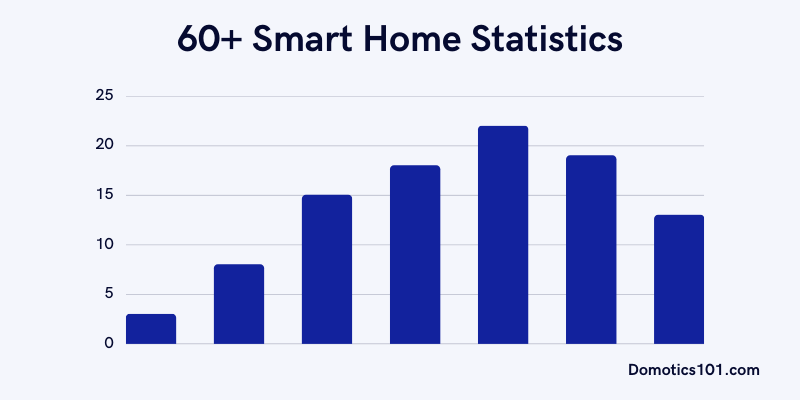
Do you want to know the state of Smart Homes in 2023? Stop your search right now.
We at Domotic101 have collected, reviewed, and organized the up-to-date Smart Home Data and Stats list below.
- You may also like: Smart Lifestyle Trends
Top Smart Home Statistics 2023
These are the most intriguing facts about Smart Homes:
- 350 million homes throughout the globe utilize smart home devices. (Statista)
- The global smart home market is currently estimated to be worth $98.05 billion; by 2032, that number is projected to increase to $581.85 billion. (Precedence Research)
- The Smart Speaker market is the best-recognized subset of the Smart Home industry, with a projected 640 million devices in use by 2024. (Statista)
- 46.5% of U.S. homes have adopted Smart Home technology so far. (Oberlo)
- Almost 25% (1 in 4) of all U.S. adults have a smart speaker like Google Nest or Amazon Echo. (MarTech)
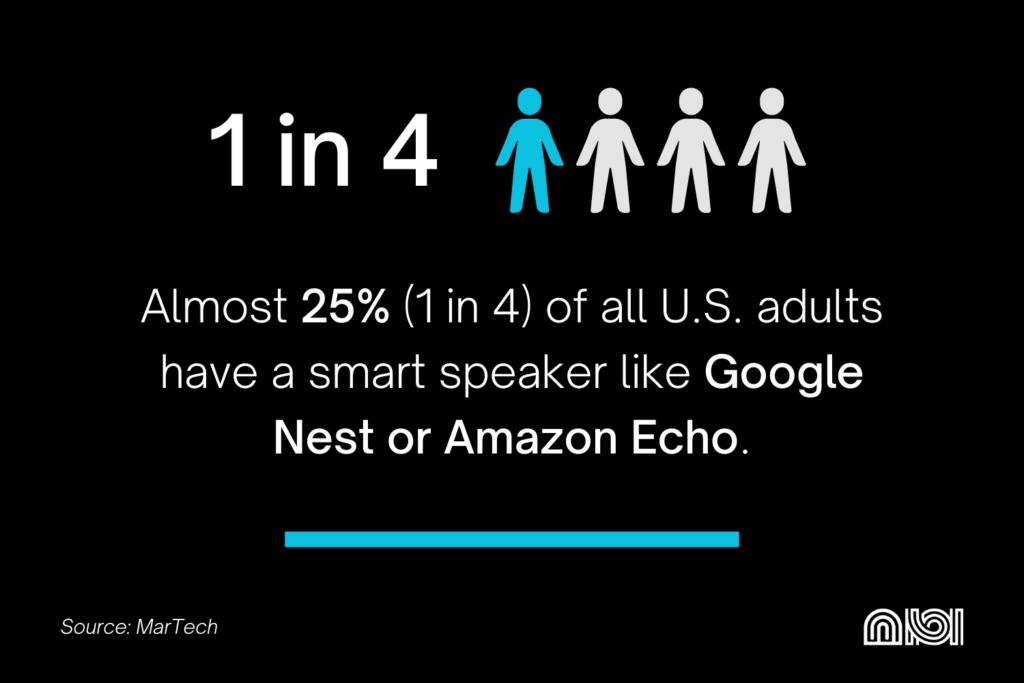
- On average, American smart homes have 8 smart devices. (GRC World Forums)
- Around 69% of American houses have at least one smart device, while 18% (or 22 million homes) have many. (MediaPost)
Smart Home Market Statistics
The Smart Home industry is increasing as the world gets more interconnected.
This section will explore market size, annual growth rate, and geographical characteristics that shape the smart home sector.
- By 2025, worldwide consumer expenditure on smart home systems will surpass $170 billion. (Strategy Analytics)
- The Asia-Pacific region has the largest smart home market. (Strategy Analytics)
- The Smart-Home market will likely have seen 5 million products by 2030. (HouseGrail)
- The “Video Entertainment” market is predicted to account for the most significant share of shipped smart home devices. (Statista)
- 40% of all smart home consumer expenditure occurs in North America. (Strategy Analytics)
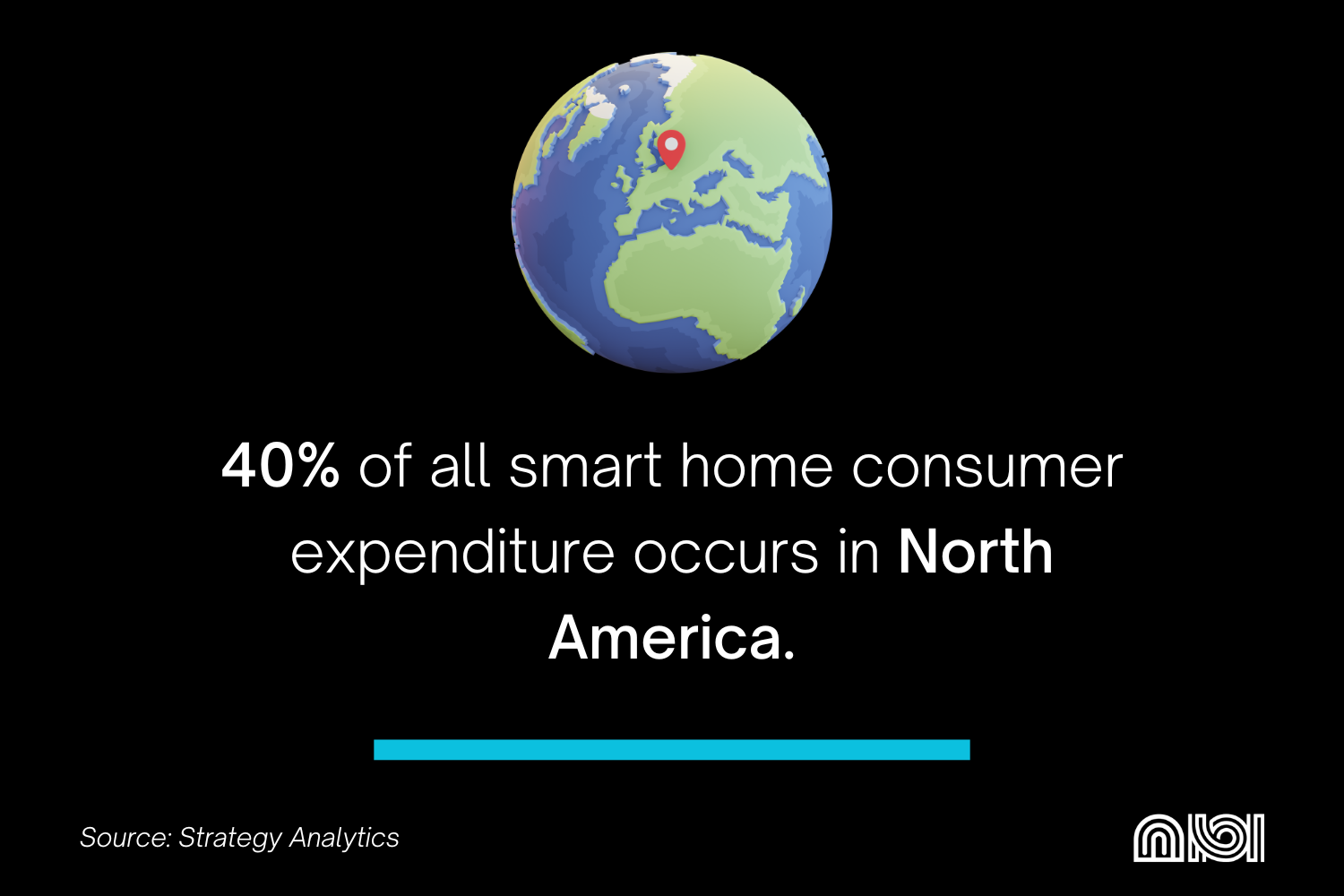
- The DIY home automation market is expected to be around $14.9 billion by 2020. (Gitnux)
- Apple, Google, and Amazon are the most prominent players in the smart home industry. (Fortune Business Insights)
- Voice-controlled devices account for 68% smart home devices market share within the smart home sector alone. (Gitnux)
- By 2023, the smart doorbell industry in the United States and Europe is expected to be worth over $1.4 billion. (Gitnux)
Smart Home Adoption Rate Stats
Smart home markets and the speeds at which their cutting-edge technology is being adopted are expanding.
We may learn a lot about consumer tastes, levels of contentment, and the spread of smart home technologies worldwide by analyzing the elements that encourage or discourage their use.
- Convenience drives the adoption of smart home technologies by 46% of consumers. (Hippo)
- 15% of all households worldwide, or 309 million houses, have adopted smart home technology. (Strategy Analytics)

- 57% of those who haven’t adopted smart home technology have no interest in doing so. (Smart Energy Consumer Collaborative)
- 64% of American millennials who own smart home products believe that 10 years later, we will see these products as common as smartphones. (Gitnux)
- More than 35 devices are expected to be linked in the typical American smart home by 2025. (Gitnux)
Smart Home Demographic Stats
To fully grasp the breadth and depth of these advancements, it is essential to have a firm grasp of the user demographics of smart home technologies.
We can learn about market smart home consumer trends, consumer tastes, and opportunities in the smart home industry by studying these users.
- 77% of smart home technology users are below the age of 55. (SECC)
- The yearly household income of 39.6% of American smart-home owners is above average. (Statista)
- About twice as many women as males were interested in a smart security system. (Security.org)
- 49% of American women and almost 82% of men have at least one smart home device. (BanklessTimes)
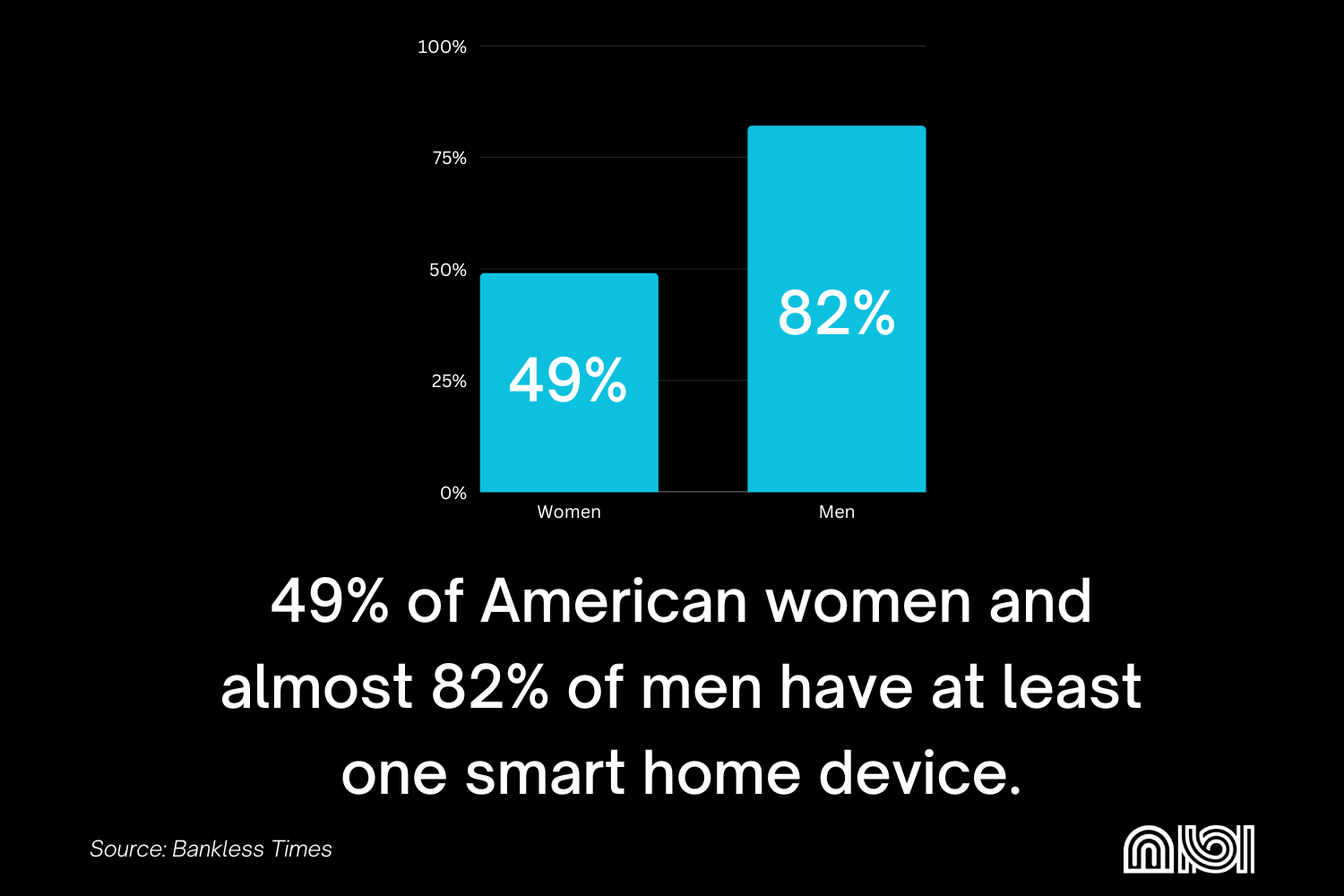
- 36% of men and women (age 35-54) believe smart cameras are the best way to keep their houses safe. (Hippo)
- For 14% of women ages 25-34, automatic smart locks are the most important smart home security device. (Hippo)
- 45% of Americans who have invested in home automation are between the ages of 25-34. (Gitnux)
Smart Home Device Statistics
Security, energy management, entertainment, and convenience are just a few areas that may be addressed by the wide variety of smart home devices on the market.
By digging into these numbers, we can get a clearer picture of the smart home ecosystem and how these devices are affecting our lives.
- 37% of consumers say “Fire or Theft alarm systems” are a smart home’s most important safety equipment. (Hippo)
- 11% of smart thermostat users had difficulty throughout the installation process. (SECC)
- 63% of smart appliance owners also have a smart thermostat. (SECC)
- 10% of smart speaker users reported reliability issues. (SECC)
- On Average, the U.S. Smarthomes own 8 smart devices. (Parks Associates)
- 70% of consumers who have invested in smart home appliances also own smart speakers. (SECC)
- 58% of smart appliance owners also have smart lighting. (SECC)
- The average cost of a smart home security system installation is $2,850. (Home Advisor)

- The average cost of having a smart home device installed is $789. (Home Advisor)
- 40% of smart thermostat owners have reported that it made their homes more comfortable. (SECC)
- In 2019, Amazon Echo was responsible for 60% of all voice-controlled smart speaker sales in the United States. (Gitnux)
Smart Home Consumer Behavior Stats
Let’s look at some intriguing findings that show the smart home revolution’s influence on customers’ lives.
- 59% of Americans are prepared to pay extra for energy-saving smart home technology because they are concerned about global warming. (BanklessTimes)
- Over a third of Americans (34%) use a voice-activated search function at least once a month. (eMarketer)
- 45% of Americans say they are willing to give up some privacy in exchange for the environmental advantages of smart home devices. (BanklessTimes)
- U.S. citizens who own smart home devices spend an average of $1,172 on smart household electronics. (BanklessTimes)
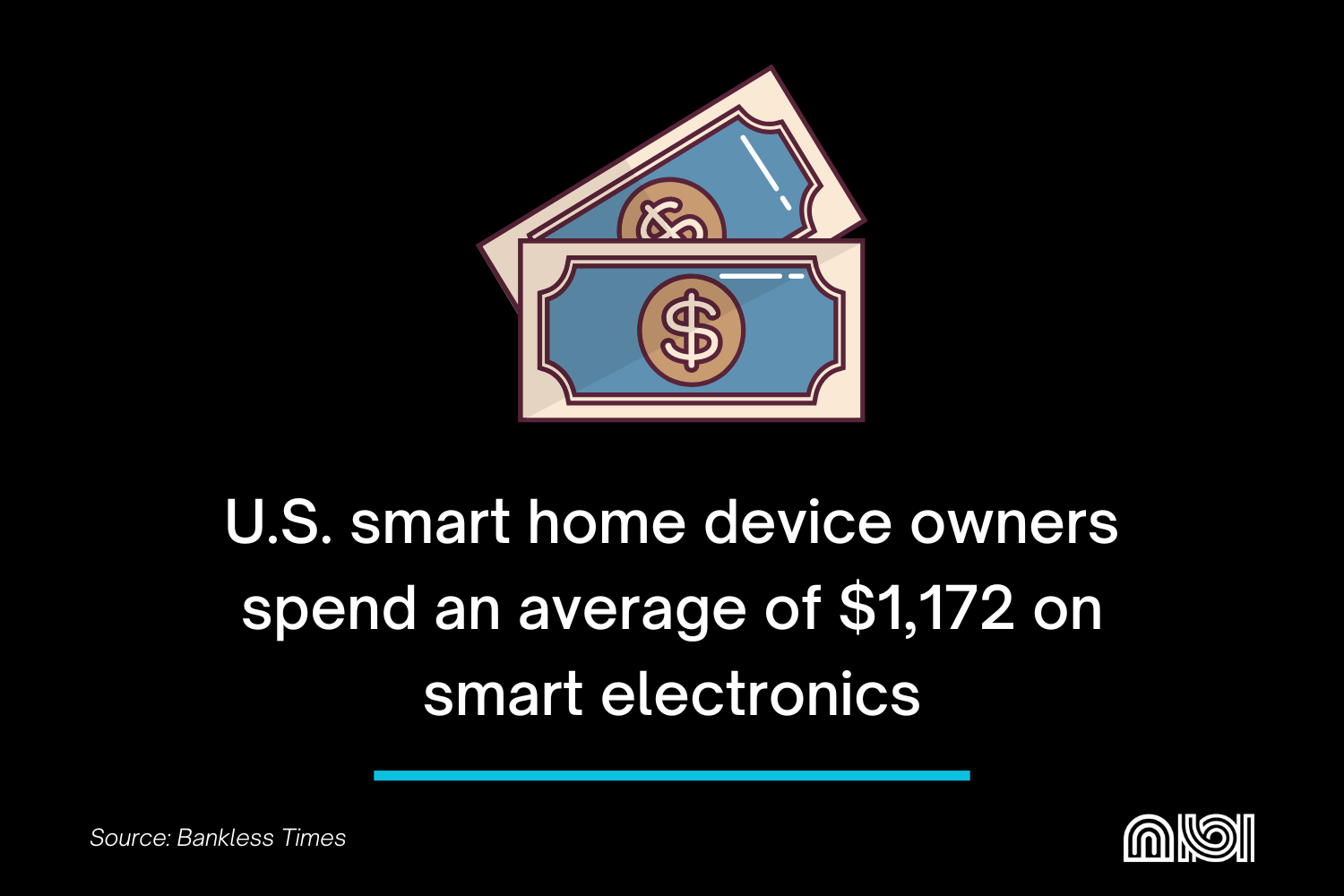
- Young adults (those aged 18-34) owns 40% of all smart home products. (MoneyZine)
- It is expected that 57% of US consumers will interact with smart home technology by 2025. (Statista)
Smart Home Demand Stats
The need for smart home technology is a significant component in this dynamic sector’s development and future course.
Let’s look at the statistics driving the growing need for smart home solutions.
- Seven out of ten buyers are interested in a smart house, and 78% (eight in ten) would pay extra for one. (Security.org)
- At least one-third of those living in rental properties consider smart home technology either “Important” or “Very Important.” (Rent.com)
- 82% of renters want at least one smart device in their homes or apartments. (Rent.com)

Smart Home Benefits Stats
Here are a few numbers that back up the many advantages of installing smart home systems.
- 57% of Americans report saving 30 minutes daily (182 hours per year) because of smart home technologies. (Rochester)
- 71% of buyers said that smart home tech was more helpful than they had anticipated. (Frontier)
- 79% of smart homeowners report that their purchases have improved their quality of life. (Frontier)
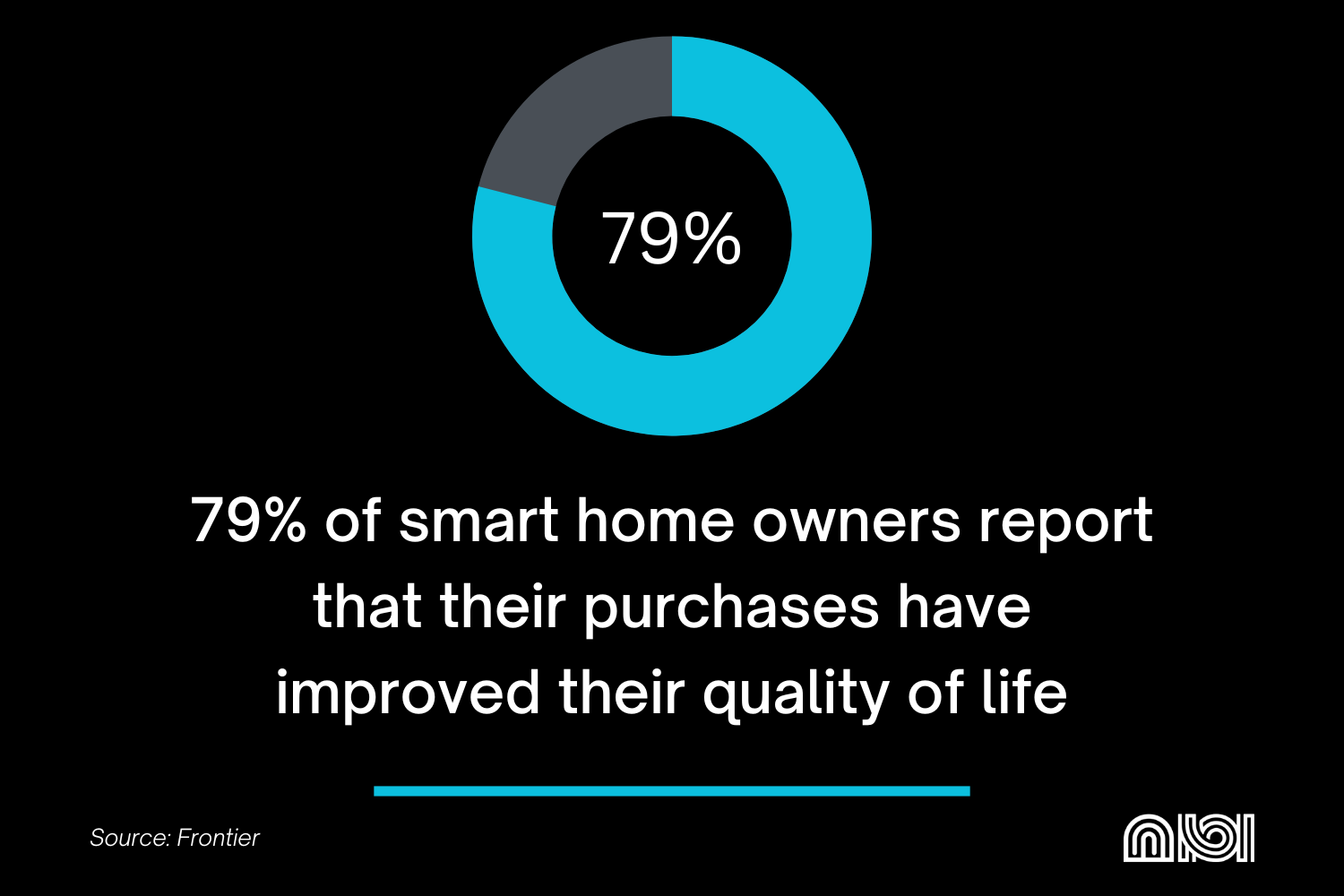
- 42% of smart thermostat owners say it has helped them reduce electricity usage. (SECC)
- 97% of smart home product owners are either “Somewhat” or “Very Satisfied” with their purchases. (SECC)
Smart Home Concern Stats
Despite the growing popularity of smart home technology, not everyone is convinced of their advantages.
Addressing customer requirements and creating confidence in the smart home market requires a thorough grasp of a wide range of concerns, from privacy and data security to dependability and initial investment costs.
- 45% of those who haven’t adopted smart home technology said they worry about sharing their personal data without consent. (SECC)
- Concern about remembering passwords is a significant issue for 23% of U.S. citizens. (YouGov)
- The initial investment required to acquire smart technology is seen as too large by 39% of non-adopters. (SECC)
- 17% of Americans are concerned about the energy expense of running these smart home devices. (YouGov)
- 10.89% of Americans are concerned about getting hacked by using these smart devices. (YouGov)
- 65% of U.S. citizens oppose using smart-home devices that gather personal data in exchange for an insurance discount. (PolicyGenius)

- 29% of Americans worry that they will be unable to utilize their smart devices if their internet connection goes down. (YouGov)
- 22% of Americans are concerned about being locked out due to the unreliability of smart products. (YouGov)
Last Thoughts on Smart Home Technology Statistics
The Smart Home market has expanded rapidly in recent years, with several products and services becoming standard in many homes throughout the globe.
Convenience, safety, energy efficiency, and environmental concerns are the only motivating elements for these technologies’ widespread use.
Thus, the smart home market worldwide is predicted to expand rapidly in the future years, reaching a whopping $581.85 billion by 2032.
Most smart home product users are pleased with their purchases. They cite multiple advantages, including time savings and enhanced quality of life, despite worries over privacy, data security, and initial investment expenses.